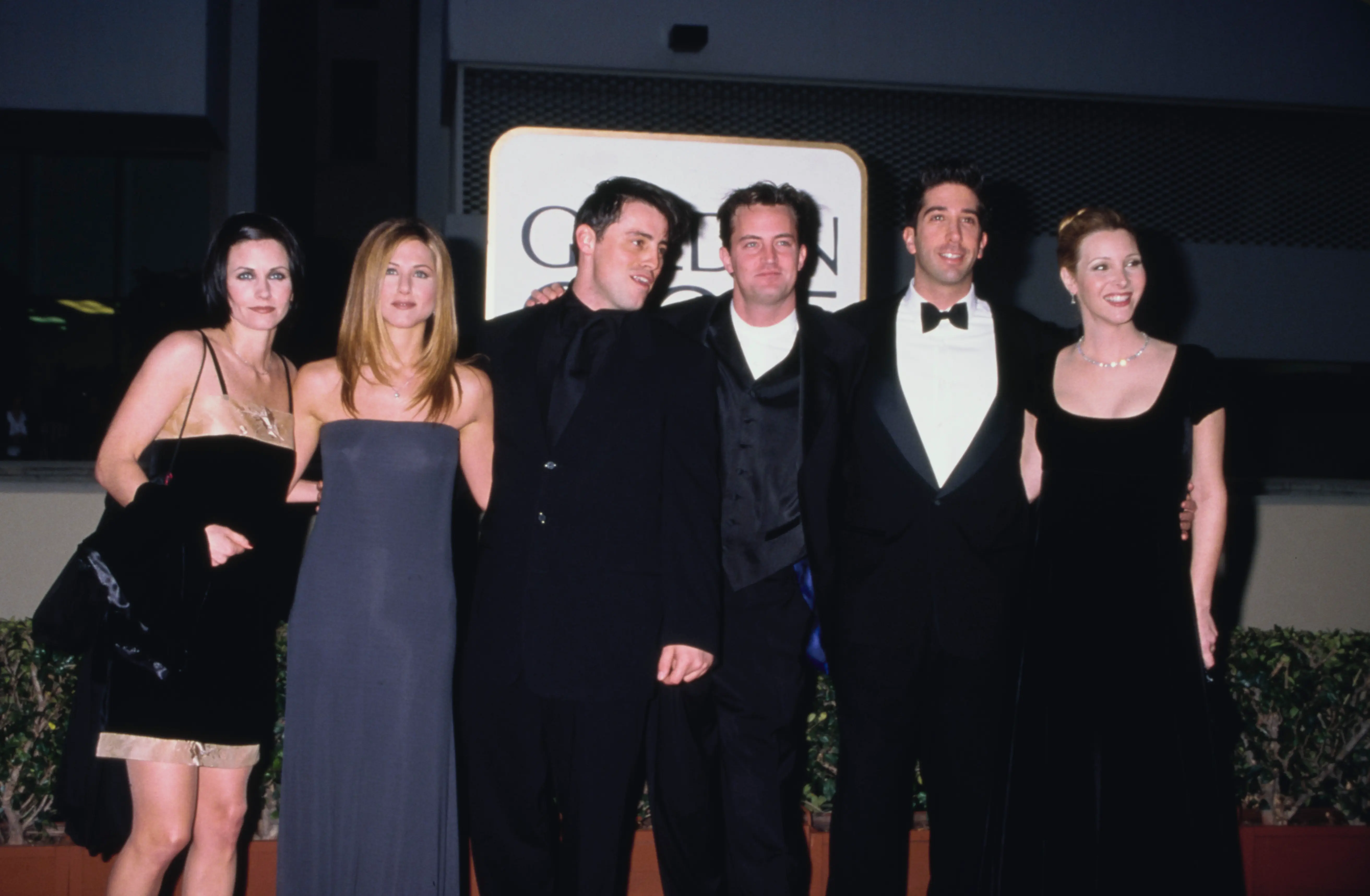Ross and Rachel’s ending on Friends exposed how nostalgia tricks us into mistaking familiarity for destiny
-
 The cast of 'Friends' (American actress Courteney Cox, American actress Jennifer Aniston, American actor and comedian Matt LeBlanc, American-Canadian actor and comedian Matthew Perry, American actor and comedian David Schwimmer, and American actress and comedian Lisa Kudrow) attend the 55th Golden Globe Awards, held at the Beverly Hilton Hotel in Beverly Hills, California, 18th January 1998. (Photo by Vinnie Zuffante/Getty Images)
The cast of 'Friends' (American actress Courteney Cox, American actress Jennifer Aniston, American actor and comedian Matt LeBlanc, American-Canadian actor and comedian Matthew Perry, American actor and comedian David Schwimmer, and American actress and comedian Lisa Kudrow) attend the 55th Golden Globe Awards, held at the Beverly Hilton Hotel in Beverly Hills, California, 18th January 1998. (Photo by Vinnie Zuffante/Getty Images)Few TV romances have been dissected as endlessly as Ross and Rachel’s will-they-won’t-they saga on Friends. Across 10 seasons, their relationship was presented as the emotional anchor of the series, culminating in a finale that millions of viewers read as a triumphant “happily ever after.” Yet, looking back, their reunion works less as a love story and more as a cultural case study in how nostalgia can blur our judgment. We mistake the familiarity of characters we’ve spent a decade with for destiny, projecting permanence onto comfort.
The ending of Friends is a lesson in how density of repetition and longing create an illusion: if we see two people stumble toward each other often enough, we assume they belong together. But what feels like fate is often just television’s ability to repackage longing into neat closure.
When closure feels like love
The famous final scene of Friends shows Rachel giving up her Paris opportunity and walking back into Ross’s apartment. The crowd roars, Ross delivers his breathless relief, and the two kiss as if a decade’s worth of turbulence has dissolved. It’s the ultimate sitcom punctuation mark: a reunion framed as destiny. But strip away the applause and slow framing, and the ending is less about romance and more about television’s sleight of hand.
The series spent 10 years training its audience to root for Ross and Rachel. Their breakups, reconciliations, jealous fits, and awkward timing were narrative fuel. By the time the finale arrived, viewers weren’t just watching a couple—they were watching a ritual. The density of callbacks, catchphrases, and emotional beats tricked audiences into mistaking nostalgia for inevitability.
If we ask whether Rachel should have abandoned her dream job for Ross, the answer is less flattering. Their history was filled with immaturity, jealousy, and mismatched priorities. Yet the sitcom format thrives on transforming longing into happy endings. Viewers don’t want reality; they want comfort. And in the end, Ross and Rachel’s “forever” functions less as a story about love and more as a commentary on how television collapses complexity into closure. It’s not romance, it’s a mirror of our desire to see longing resolved in the easiest way possible.
The finale leaned on a decade’s worth of longing, packaging it into a crowd-pleasing conclusion that satisfied audiences but strayed away from reality. It’s a powerful reminder that these on-screen love stories aren’t blueprints for real relationships, as real life doesn’t work that way. Instead, they just provide a temporary respite from the tough ordeals of life and act as reflections of our desire for closure and comfort. The couple’s ending isn't simply about love conquering all.
A brief overview of Friends
The sitcom Friends followed six friends in their 20s navigating life in New York City. The combination of the actors’ chemistry, witty writing, and universal themes of friendship turned the show into one of the defining comedies of the 1990s and early 2000s. All nine seasons of Friends are available for streaming on HBO Max in the United States, but viewers will require an appropriate subscription plan to access the catalog. Additionally, the sitcom can also be purchased via Amazon Video, starting at $2.99/episode.
The series was created by David Crane and Marta Kauffman, produced by Kevin S. Bright, and ran for 10 seasons on NBC. The cast for the series included Courteney Cox as Monica Geller, Matthew Perry as Chandler Bing, Matt LeBlanc as Joey Tribbiani, Lisa Kudrow as Phoebe Buffay, David Schwimmer as Ross Geller, and Jennifer Aniston as Rachel Green.
Stay tuned with us for further updates.
TOPICS: Friends
- Who is Jasveen Sangha? Parents and more about Hollywood’s Ketamine Queen as she pleads guilty in connection to Matthew Perry’s death
- “I wonder how much this moron will pay”: Plasencia mocked Matthew Perry in texts while allegedly supplying him $4,500 worth of ketamine before his death
- Dark fan theory about Phoebe from Friends sparks explosive debate online
- Rewatching Friends in 2025 changes one core relationship completely